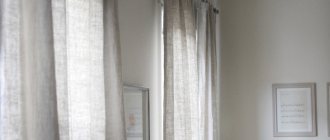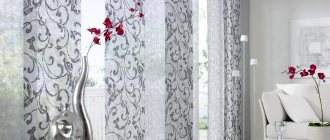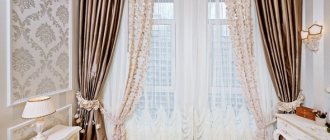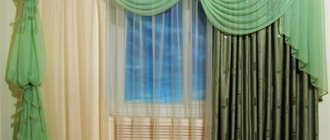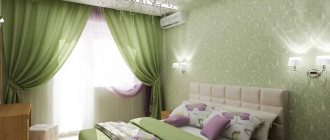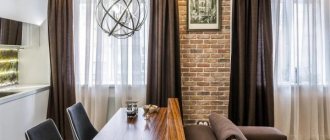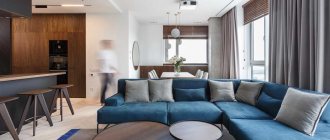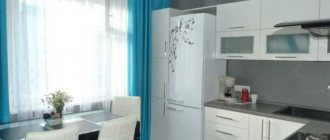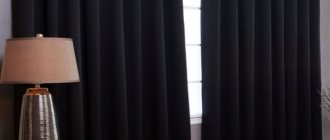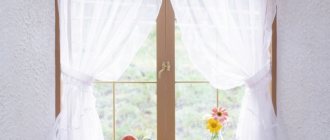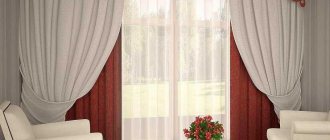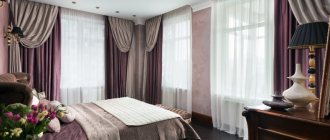The environmental friendliness and external beauty of a material such as linen captivates many in interior design. A room with linen textiles is always cozy, comfortable and warm. Today we’ll talk about curtains: their varieties, color combinations, advantages and disadvantages.
Types of linen fabrics
Initially, many people associate linen with a rather rough and inelastic fabric. But this is absolutely not true. Once upon a time in Ancient Egypt, up to 250 m of the finest linen threads were obtained from just 1 kg of raw materials, and the linen itself was incredibly delicate, flexible and light. Its price was not cheap, so only rich people bought clothes made from such fabric, while ordinary people were really content with hard and rough fabric. Today, the textile industry produces a variety of types of linen, from which you can choose curtains (or fabrics) for any interior.
Unbleached linen looks like homespun fabric with dark gray-brown tones, on the surface of which the weaving of threads is clearly visible. Designers prefer to use this type of linen fabric in safari, rustic, Scandinavian, eco and other design directions that are as close to simplicity and naturalness as possible.
Lightened canvases in gray-white, cream, milky shades look fresh and airy. Such curtains create a special light and cozy atmosphere in the design of Provence, grunge, country and will be an excellent choice in the interior of the kitchen.
Active designers use dense fabric with a pronounced relief texture to decorate bedrooms and living rooms. Such linen textiles look expensive and luxurious, while preserving the natural beauty of the material. In modern, gothic, and African styles, linen will be incredibly organically combined with decorative elements.
Linen with silk, as well as with lavsan, with a pleasant matte sheen, further ennobles the interior in a classic, antique, art deco style. Such bedspreads and curtains give the room sophistication, sophistication, aristocratic luxury, and emphasize the richness of the interior.
Note: when choosing linen textiles for curtains, pay attention to the pattern. Greek print looks harmonious in antique design, and floral pattern is best used for oriental, colonial or Slavic style.
Style solutions for linen curtains
Despite the simplicity of the material, linen curtains can be made in a wide variety of residential designs.
Scandinavian style. The name itself already means that the style is dominated by cold tones and a North Sea theme. Therefore, it is good to use bleached or grayish linen with a smooth texture here. On the contrary, dense material reminiscent of canvas fabric will create a Nordic atmosphere. Choose a print that will be combined with other decorative elements, for example: marine patterns, anchors, ropes.
High tech. The style of high technology and functionality does not interfere with the existence of natural textiles in it. Linen curtains in the interior of the living room can emphasize the minimalism that is inherent in high tech.
Provence and Country. Linen curtains in a rustic style will be predominantly yellowish in color with the presence of embroidery, lace and hemstitching. Such curtains will complete the interior with wooden furniture and other stylish decor. The density of the fabric is selected in accordance with the degree of illumination of the room.
Eco. For those who prefer an interior with natural materials, linen curtains will be a lifesaver. The color and density of the material will depend on the overall design theme and dominant elements. Most often, leather, stone, wood or cork material is used in such an interior.
Advantages and disadvantages of flax
When choosing any fabric, we first of all pay attention to its quality and properties. Even an amateur understands that wool cannot withstand high temperatures, and cotton wrinkles badly. Let's see what the pros and cons of flax are.
Linen perfectly allows heat and air to pass through, which is good for health. The material has high environmental qualities and does not cause any allergic reactions.
Flax fiber itself is very durable, which determines its long service life. Suffice it to recall how linen products, having experienced numerous washes, were passed on by inheritance, but at the same time retaining their presentable appearance. However, keep in mind that after washing, linen fabric shrinks by 7%. Therefore, when calculating the footage of curtains, buy textiles with a margin.
Pure linen fabric, without additives, wrinkles quite a lot. Perhaps this is the main disadvantage of natural flax. Each wash is not complete without long and thorough ironing of linen curtains to give them a flawless, smooth look.
Tip: it is better not to use aggressive detergents when washing linen curtains. Otherwise, the fabric may quickly become thin and lose its original attractiveness. To avoid stains, buy powders that do not contain chlorine.
Features of linen curtains
Even natural fabrics have their advantages and disadvantages. Fortunately, there are more advantages, but you also need to be aware of the disadvantages. For example, woolen material does not tolerate elevated temperatures, and 100% cotton without additives tends to “shrink” after washing.
Color combination and decoration
When decorating the interior, remember that linen does not have rich, bright or snow-white colors. The whole highlight of this textile is in its pastel, delicate and soft tones of the creamy beige spectrum. Therefore, linen fabric in the interior is universal in terms of combining shades. There are almost no prohibitions for her.
Linen textiles will add sophistication and originality to the kitchen and living room in purple, blue or peach colors. In a brown, green, white interior, linen curtains will be as harmonious as possible. And the snow-white background of the walls will not overshadow the natural fabric at all, and all thanks to its texture!
The decorative component of linen curtains is most often lace or embroidery. Lace braid or hemstitch visually lightens the fabric and creates a feeling of some airiness. Curtains with similar decor look charming both in the bedroom and in the kitchen.
A magnificent effect is produced by combining linen curtains with tulle or a snow-white veil.
In drapery, this material is quite complex. Natural beauty is created by vertical folds, but Austrian curtains, cascades or lambrequins turn into a pile of fabrics, devoid of any aesthetics and smoothness of waves. The laconic simplicity in the design of such curtains looks much more interesting and comfortable.
Linen fabric with embroidery is aerobatics. Both cross stitch and satin stitch fit flawlessly on linen. The fabric plays in a completely new way, and a special atmosphere, style and color appear in the interior.
Linen in interior design
As mentioned earlier, linen is quite common in interiors. This material is especially loved by designers when decorating rooms with natural fabrics. The popular soft beige tone of the canvas is a universal material for curtains in almost any interior. Pastel Provence or presentable classics, national original flavor or rustic minimalism - in each of these styles linen looks very organic.
This practical material is especially in demand when decorating windows in the kitchen. In the living room, linen textiles give a fascinating play of light, thanks to the folds of the fabric, randomly transmitting the bright rays of the sun. If you want to emphasize the expensive minimalism of linen curtains, combine them with light cambric or mesh tulle. You can add a touch of luxury to the interior of the front room using linen with sewn satin inserts or metallic thread.
Nowadays, people sometimes lack unity with nature. And natural materials in the home interior are a real salvation. Linen is perfect in this regard; it fills our everyday life with comfort, warmth and harmony.
